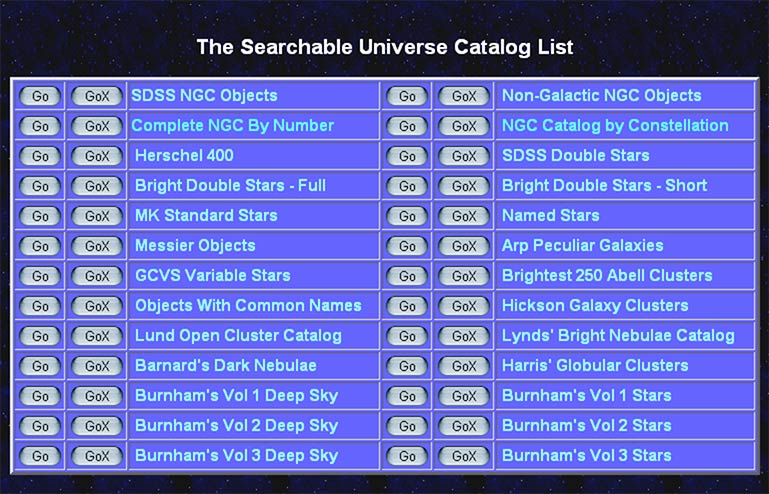Welcome to the Searchable Universe!
At one time this site contained a collection of online interactive celestial catalogs. It was suitable for use by anyone with an interest in astronomy. To begin, you first would read the Site Info pages and then go to the catalogs by clicking the Catalogs button. From the time I was a little kid I was always fascinated with
Site Last Updated 5/2/04 by the original owner, Guy Maxim.
The page you see now was reconstructed from the site’s archived pages.
The fans of this site will recognize the name Wilbur Cotton, who is credited with creating a truly massive and long lasting popularity for AltairFour.net among a very valuable demographic - new visitors. It's a very unlikely story and sets the archive up perfectly. Wilbur's company manufactured highly specialized additives used in cleaning agents, especially economical dish soap and wholesale dishwasher detergents. His proprietary formulas prevented the soap from leaving dishwasher stains on glassware, but also prolonged the benefit of the aromatics used in the soap - a property soon recognized by the perfume industry. He became a very wealthy man. When asked about the formula on the Today Show, he claimed (as a joke) that the formulations were conceived after examining celestial charts and that there were many other secrets hidden in the stars. Of course, that interview, which was also posted on YouTube, included a mention of this site. And that's how dishwashing genius Wilbur Cotton drove so much traffic to AltairFour.net that it had to add server capacity to serve the new traffic. It's actually a real success story and has become part of the history to be archived.

General Site Information
The Searchable Universe is a collection of 26 celestial object catalogs. The catalogs contain several thousand objects of interest to amateur and professional astronomers. The Searchable Universe differs from the typical catalog in that each object is hyperlinked to a variety of information. With this site you can retrieve images, astrometric data, spectrographic information, bibliographic references, finder charts and observing lists. This does not include whatever information that can be found with a general web search. In short you can retrieve a staggering amount of information for most of the objects in the catalog with just a few mouse clicks.
The catalogs are all in the same format, as described in the Catalog Format help page, but the information content will vary from catalog to catalog. If you can learn to use one catalog, you can use them all. To use the catalogs it would be helpful to be familiar with the following concepts.
- The types of objects that astronomers study and their characteristics. Globular clusters, planetary nebula, double stars, diffuse nebula, etc.
- What and where the constellations are.
- The nomenclature used to name celestial objects, e.g. NGC 2932, M 45, HD 203332.
- The concepts of right ascension, declination and visual magnitude.
With only these basic ideas you will be able to understand the data as it is presented here. My advice: you can't break anything so pick a catalog and play. There's a whole universe to explore!
Disclaimer: The information presented on this site is intended solely for educational and research purposes. Any commercial use may be a violation of copyright law.
+++
The Catalogs Page
The catalogs page is where you will go to select a catalog. This is the "Catalogs" link on the home page. The page itself is shown below .

To open a catalog, click on Go or GoX. The GoX version will work only on machines that are running the Microsoft XP operating system or have Office XP installed or have Office XP Components installed. The advantage of this version is that you get something that looks and acts like a true interactive spreadsheet. The disadvantage is that you have to download the whole catalog at once whereas the Go version lets you download one page at a time. Most of the GoX versions are over 2 megabytes and some exceed 10 megabytes. I suggest that you save these pages to your local hard drive and load them from there. The contents of the catalogs are static so you won't miss anything by doing this.
The "H" button on the bottom returns you to the home page.
+++
Catalog Format
All of the catalogs are presented in spreadsheet format as shown below. If the catalog has more than one page, a row of tabs will appear at the bottom of the screen. The catalog below has four pages - Spring, Summer, Fall and Winter. Clicking on a tab will bring up that page. If the page is too big to fit on the screen, it may be scrolled vertically and horizontally.

Every catalog will have a column for primary object name, right ascension and declination. These will be labelled ID, RA and DEC respectively. The other columns will vary. You can find out what the catalog columns mean by clicking on the top row cell labelled Info . This will bring up an information page for the catalog. Each row contains at least four hyperlinks. These are described in the next help page. Below is the GoX version of the same catalog. In this form you can sort the data, selct subsets of the data and export directly to Excel on your local machine. You can also highlight rows which can make using the catalogs a bit easier.
